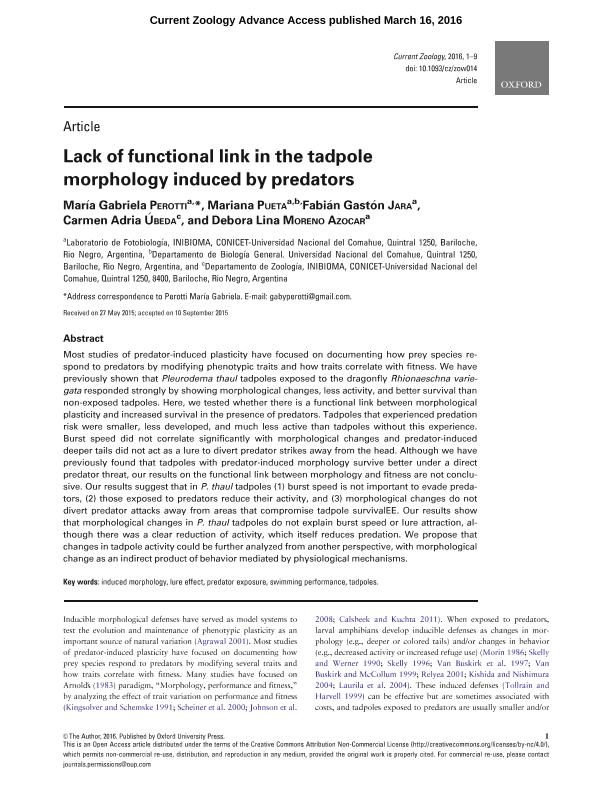Mostrar el registro sencillo del ítem
dc.contributor.author
Perotti, Maria Gabriela

dc.contributor.author
Pueta, Mariana

dc.contributor.author
Jara, Fabian Gaston

dc.contributor.author
Ubeda, Carmen Adria

dc.contributor.author
Moreno Azócar, Débora Lina

dc.date.available
2019-02-14T20:25:37Z
dc.date.issued
2016-03-16
dc.identifier.citation
Perotti, Maria Gabriela; Pueta, Mariana; Jara, Fabian Gaston; Ubeda, Carmen Adria; Moreno Azócar, Débora Lina; Lack of functional link in the tadpole morphology induced by predators; Oxford University Press; Current Zoology; 62; 3; 16-3-2016; 227-235
dc.identifier.issn
1674-5507
dc.identifier.uri
http://hdl.handle.net/11336/70227
dc.description.abstract
Most studies of predator-induced plasticity have focused on documenting how prey species respond to predators by modifying phenotypic traits and how traits correlate with fitness. We have previously shown that Pleurodema thaul tadpoles exposed to the dragonfly Rhionaeschna variegata responded strongly by showing morphological changes, less activity, and better survival than non-exposed tadpoles. Here, we tested whether there is a functional link between morphological plasticity and increased survival in the presence of predators. Tadpoles that experienced predation risk were smaller, less developed, and much less active than tadpoles without this experience. Burst speed did not correlate significantly with morphological changes and predator-induced deeper tails did not act as a lure to divert predator strikes away from the head. Although we have previously found that tadpoles with predator-induced morphology survive better under a direct predator threat, our results on the functional link between morphology and fitness are not conclusive. Our results suggest that in P. thaul tadpoles (1) burst speed is not important to evade predators, (2) those exposed to predators reduce their activity, and (3) morphological changes do not divert predator attacks away from areas that compromise tadpole survivalEE. Our results show that morphological changes in P. thaul tadpoles do not explain burst speed or lure attraction, although there was a clear reduction of activity, which itself reduces predation. We propose that changes in tadpole activity could be further analyzed from another perspective, with morphological change as an indirect product of behavior mediated by physiological mechanisms.
dc.format
application/pdf
dc.language.iso
eng
dc.publisher
Oxford University Press

dc.rights
info:eu-repo/semantics/openAccess
dc.rights.uri
https://creativecommons.org/licenses/by-nc/2.5/ar/
dc.subject
Induced Morphology
dc.subject
Lure Effect
dc.subject
Predator Exposure
dc.subject
Swimming Performance
dc.subject
Tadpoles
dc.subject.classification
Otras Ciencias Biológicas

dc.subject.classification
Ciencias Biológicas

dc.subject.classification
CIENCIAS NATURALES Y EXACTAS

dc.title
Lack of functional link in the tadpole morphology induced by predators
dc.type
info:eu-repo/semantics/article
dc.type
info:ar-repo/semantics/artículo
dc.type
info:eu-repo/semantics/publishedVersion
dc.date.updated
2019-02-05T19:53:24Z
dc.identifier.eissn
2396-9814
dc.journal.volume
62
dc.journal.number
3
dc.journal.pagination
227-235
dc.journal.pais
Reino Unido

dc.journal.ciudad
Londres
dc.description.fil
Fil: Perotti, Maria Gabriela. Consejo Nacional de Investigaciones Científicas y Técnicas. Centro Científico Tecnológico Conicet - Patagonia Norte. Instituto de Investigaciones en Biodiversidad y Medioambiente. Universidad Nacional del Comahue. Centro Regional Universidad Bariloche. Instituto de Investigaciones en Biodiversidad y Medioambiente; Argentina. Universidad Nacional del Comahue. Centro Regional Universitario Bariloche. Laboratorio de Fotobiología; Argentina
dc.description.fil
Fil: Pueta, Mariana. Consejo Nacional de Investigaciones Científicas y Técnicas. Centro Científico Tecnológico Conicet - Patagonia Norte. Instituto de Investigaciones en Biodiversidad y Medioambiente. Universidad Nacional del Comahue. Centro Regional Universidad Bariloche. Instituto de Investigaciones en Biodiversidad y Medioambiente; Argentina. Universidad Nacional del Comahue. Centro Regional Universitario Bariloche. Laboratorio de Fotobiología; Argentina
dc.description.fil
Fil: Jara, Fabian Gaston. Consejo Nacional de Investigaciones Científicas y Técnicas. Centro Científico Tecnológico Conicet - Patagonia Norte. Instituto de Investigaciones en Biodiversidad y Medioambiente. Universidad Nacional del Comahue. Centro Regional Universidad Bariloche. Instituto de Investigaciones en Biodiversidad y Medioambiente; Argentina. Universidad Nacional del Comahue. Centro Regional Universitario Bariloche. Laboratorio de Fotobiología; Argentina
dc.description.fil
Fil: Ubeda, Carmen Adria. Consejo Nacional de Investigaciones Científicas y Técnicas. Centro Científico Tecnológico Conicet - Patagonia Norte. Instituto de Investigaciones en Biodiversidad y Medioambiente. Universidad Nacional del Comahue. Centro Regional Universidad Bariloche. Instituto de Investigaciones en Biodiversidad y Medioambiente; Argentina. Universidad Nacional del Comahue. Centro Regional Universidad Bariloche. Departamento de Zoología; Argentina
dc.description.fil
Fil: Moreno Azócar, Débora Lina. Consejo Nacional de Investigaciones Científicas y Técnicas. Centro Científico Tecnológico Conicet - Patagonia Norte. Instituto de Investigaciones en Biodiversidad y Medioambiente. Universidad Nacional del Comahue. Centro Regional Universidad Bariloche. Instituto de Investigaciones en Biodiversidad y Medioambiente; Argentina. Universidad Nacional del Comahue. Centro Regional Universitario Bariloche. Laboratorio de Fotobiología; Argentina
dc.journal.title
Current Zoology
dc.relation.alternativeid
info:eu-repo/semantics/altIdentifier/doi/http://dx.doi.org/10.1093/cz/zow014
dc.relation.alternativeid
info:eu-repo/semantics/altIdentifier/url/https://academic.oup.com/cz/article/62/3/227/2897733
Archivos asociados
